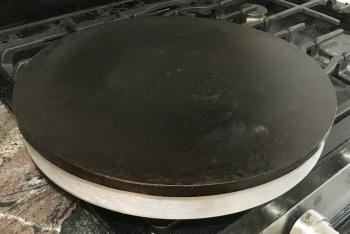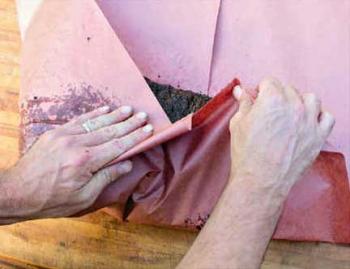-
Posts
1,744 -
Joined
-
Last visited
-
Days Won
53
Content Type
Profiles
Forums
Events
Everything posted by Syzygies
-
Yes. I don't like my instrumentation to offer opinions. When you buy a high end mountain bike, it may not come with peddles. Too personal a choice. The KK on the other hand arrives good to cook, which I wouldn't change. However, my original KK thermometer is lost in the sea of entropy that is my garage. I use two Tel-Tru thermometers in different ranges.
-
Exactly as Robert does. And hitting the pieces together is fun. Do it with conviction, as practice for when people are watching. I ended up buying a second charcoal basket, which I store on a terra cotta plant saucer. This way I can set unused CoCo aside without handling it, to use hardwood charcoal for hotter cooks.
-

Best vacuum packer? (FoodSaver alternatives?)
Syzygies replied to Syzygies's topic in Relevant Product Reviews
VacMaster 4-mil pouches I stock 6x6, 6x12, 8x10 and 10x12. I use both 6" bags all the time, while 1,000 of the larger sizes is a lifetime supply. If I had to pick two sizes I'd go for 6x6 and 8x10, although 6x6 and 10x12 would cover more cases. -

Best vacuum packer? (FoodSaver alternatives?)
Syzygies replied to Syzygies's topic in Relevant Product Reviews
VacMaster VP215 Today (April 6, 2016) only, VacMaster is selling (at least in the US) the VP215 for 30% off, using code CHAMP. That comes out to $630, less than I paid for my smaller air pump VP115. I recognize the pecking order here. I love the size of my VP115. The oil pump of the larger VP215 is an extra step but worth it by all accounts. My VacMaster has worked for years in light duty home use. The vacuum is chamber machine league, blowing away any clamp machine. Would a better oil pump create a more extreme vacuum? Likely, but I haven't actually needed this. Would an oil pump survive moisture better, following the above notes? Of course, but I've been careful, and I'm factoring in the expense of replacing my machine against the cost of a several times more expensive machine I wouldn't need to replace. Light duty home use here, and I have other expenses. We still have no problems "processing the hunt" e.g. taking an hour to repack a 3 kilo tin of the best anchovies on earth into 4 anchovy packets. For subjective impressions of quality, any chamber machine beats any clamp machine. I'm comparing with very expensive clamp machines. After this, 4 mil bags beat 3 mil bags. One should move to 4 mil bags before worrying about which chamber machine. Many people covet the VP215 as a step up from my VP115. I also covet expensive machines like the Henkelman. It would take personal experience with a machine failing at a quarter of the price, to make me jump. -
BBCode (wikipedia) The one reason I used raw BBCode mode before was to edit the "link text" for URLs, because the default link text used to be the URL itself, hideous and amateur in appearance. That has been fixed, with a second line available in the dialog box to provide the "link text". While I abstractly mourn the loss of a toggle for raw BBCode mode, this is now easier!
-

6″ ROTISSERIE CRADLE Verses 8" ROTISSERIE CRADLE
Syzygies replied to heavenlyink's topic in KK Features & Accessories
On a gas grill many moons ago, the best chicken I made was salted, rotisserie with smoke box. On a Weber even longer ago, the best chicken and duck I made was direct over mesquite lump. (My tastes have changed.) I made many tries with a rotisserie and my KK. Even if cleanup was a push, I'd prefer direct grilling in a rather hot KK over a nearly spent fire, after brining and spatchcocking or further parsing the chicken. And cleanup is not a push. Some of us honestly wish we'd never heard of a rotisserie. But they are fun. -
The calculator picks the single temp best suited to one's tastes, if one is going to use a single temp. It's in the nature of the beast that any single temp approach will be inferior to protocols like Tony is exploring. It's a hook shot, he needs English on the ball, because the whites and yolks have different needs.
-
eBay: 1 Aluminum Disc, 1 1/4" thick x 14 3/4" dia., Mic-6 Cast Tooling Plate, Disk (21.6 lbs, $54 USD) So I noticed while making English Muffins that my custom 1/2" x 15" Baking Steel round was having trouble heating evenly. Copper has a great thermal conductivity but it's very expensive. By cost, aluminum is the most efficient conductor. Some people will make pizza directly on an aluminum plate like this; others have noticed that a blackened, seasoned steel plate radiates better. Think of my stack as component stereo. These disks are actually scraps from cutting holes in aluminum plates, sold for less than one would pay to cut the hole. They need some cleanup, easily accomplished with a power sander and very fine tooth, premium sandpaper. Then rubbing alcohol. It takes lots of thermal mass to turn 400ml of water or ice into steam, for simulating a commercial bread oven in a KK or indoor oven. I use steel chain in a cast iron skillet, loosely following Thomas Keller's advice from The Bouchon Bakery. One of these disks in an appropriate vessel would make an interesting alternative.
-
I bought two bigger Tru-Tels, with different ranges. A trivial expense and a trivial customization. The stock thermometer is fine.
-

Yea or Nay ~ Modify Charcoal Basket?
Syzygies replied to DennisLinkletter's topic in KK Announcements
I was an early adopter of two baskets, to preserve KK lump between low & slows, while swapping in different charcoal for pizza and such. I highly recommend this approach. I keep my spare on a terra cotta plant saucer. The main issue is ash dropping through at rest, not pieces flying out during transfer. It wouldn't mean much to me to make this design change. My two baskets will outlast me, and the area between my KK and my garage gets dirty, then the wind sweeps it clean. Leaves from trees (a mild fire risk, I suppose) are a bigger concern than debris from the KK. However, some people are placing their cookers in pristine environments. There's no reason one needs to make any mess while using a KK, and this change would help, at least for those sales. Before one tastes food from this cooker: "I don't want a mess on our beautiful terrace!" After one tastes food from this cooker: "Wow. Whatever it takes! When can we do this again?" So this is probably a pre-sales question. -
I love the independent science project aspect of sous vide. It's part of the scientific tradition that anything true is reproducible. One should be able to reproduce the literature, while pretending that there is no literature. Is there a literature? While I find Serious Eats at times amusing, I really dislike their Cooks Illustrated intellectual ancestry, "We swooped in for a day trying everything once, to debunk a century of tradition!" Yeah, right. They miss so much with their "we won't publish anything till we find the cute twist we can add!" hubris. On the other hand, Modernist Cuisine is a well funded billionaire's hobby, representing years of work that wasn't for the money, rather than a day's work to keep web traffic coming. Do I presume that their fearless leader has a natural gift for cooking? Yes, though perhaps not world class. Nevertheless, this question is science, one shouldn't need a natural gift to reproduce the answer. Yes, sous vide eggs are a question of both time and temperature, because the whites and yolks have different needs. This is discussed in the Modernist Cuisine books to far greater length than we ever will. This web page is a rough summary: The Secret to the Perfect Soft-Boiled Egg It sounds like you're homing in on the same answer. There is likely a unique approach, once one parametrizes for doneness.
-
A head's up, I didn't realize at first that one could buy 4 mil chamber vacuum sealer pouches. They're not as widely available. In use, I can see no disadvantage whatsoever to 4 mil over 3 mil, and many advantages. They're subjectively far more durable. I've seen 3 mil bags fail because an air bubble pierced in the freezer, causing me to lose chicken stock into a water bath. I've seen 3 mil bags fail because a large salt crystal pierced through, packaging salt cod for a chest freezer. I still use bone guards on occasion (6 mil squares one adds for extra protection) but they're needed much less often. And did I say that after you get used to 4 mil, a 3 mil pouch in a hot sous vide water bath just feels flimsy? They cost about a nickel each, I can't imagine anyone here going through quantities where the unit price becomes an issue. Rather, the main issue is that one buys 1,000 bags at a time. They come in four packs of 250, an easy pallet share if one were so motivated. (I'm too busy to make promises.) I own a VacMaster VP115, and my working set of four bags are 6 x 8, 6 x 12, 8 x 10 and 10 x 12. One could scrimp by leaving out the 6 x 8 and cut down 6 x 12 as needed, but the small bags are very convenient for small items. One wants to standardize on a single bag thickness (4 mil for me) to avoid having to reset the sealing time each use, often forgetting. I also use these bags with a $30 impulse sealer, usually the 6 x 12 size. Liquids, and anything hot, can wreck a chamber machine. One can squeeze/burp nearly all of the air out of a bag, hanging off the impulse sealer, if the contents are wet enough. We put up our year's partially dried tomatoes this way. Having tried absolutely everything for storing stock, I try not to be judgmental in other people's kitchens, "oh yeah, that was me twenty years ago", impulse-sealing a chamber pouch of stock is the ideal storage and reheat solution. (To be fair, other people are just trying to achieve "good enough" and get on with their lives, they're probably thinking that I'm Dennis-grade OCD. But hey, I'm here talking to the cult of Dennis.) Some people will note that a chamber vacuum machine can be used just fine with liquids, if one takes care, and they take umbrage that one wouldn't use a chamber vacuum machine for everything, after ponying up the bucks. I'd love to enter a $1,000 stakes race, filling bags with stock. The impulse sealer is much faster. Pay attention while entering the site, for a 15% coupon, then buy everything on one order: VacMaster > BAGS, ROLLS > CHAMBER VACUUM SEALER POUCHES > 4-MIL
-

Komodo Kamado 42" SBB is a reality!
Syzygies replied to DennisLinkletter's topic in KK Announcements
There is no doubt that Dennis thought about everything; he can't help it. Coming from an older design that looked turned on a lathe, the asymmetric shape of a KK looked funny at first to me. It is entirely deliberate, for example to maximize height over the grill. Dennis thought about convection, placing the chimney that far back. (Aaron Franklin, another smoke whisperer of Franklin Barbecue fame, also reworked chimney positions for his designs.) A key factor here is that any KK is far better insulated than other brands in the category. So there simply isn't that much convection, even at high temperatures, compared to other cookers. KKs stabilize, quickly, and one needs and wants less airflow. -
Now you should try making your own English muffins. As breads go, they're dead simple, and they taste very, very good made fresh. King Arthur Flour English Muffin Recipes We grind our own flour and use sourdough starter, but these are established habits. One needs to tend the griddle (we used a Baking Steel) and then finish in the oven. Comals like made by La Chamba from black Colombian clay are said to heat more evenly, but I haven't tried this.
-
A round Baking Steel fits nicely. 16" is biggest, 15" will also fit inside a standard oven. I custom ordered a 1/2" 15" which I'm very happy with. Stovetop, these are crepe pans of the gods, also tortillas, chapati and dosas, any flat bread. They'll also custom order 3/8" thick, though 1/4" thick is fine, just less thermal mass for some applications like scaring the bejeesuz out of a sous vide steak. Ideal for burgers. Baking Steel
-

Komodo Kamado 42" SBB is a reality!
Syzygies replied to DennisLinkletter's topic in KK Announcements
-
How about Centigrade only? People in Fahrenheit land aren't real comfortable with numbers, are they? They certainly don't use weights in recipes. I thought they checked temperatures with their pointer finger?
-
Yes, small and bone-out will cook faster. Try a whole shoulder (butt + picnic, bone in) for the other monumental extreme. As a bonus one gets many kinds of muscle, a carnival of flavors. Be careful ordering this, as the language is so debased that even professionals equate shoulder and butt. Berkeley Bowl once sold me a two butt vacuum pack as a whole shoulder; luckily the symmetry tipped me off before I had paid and left the store. So ask what the local dialect calls a bone-in shoulder+picnic in one piece. If they offer you a vacuum pack, always a good idea to have them open it (for a fragrance check), and then one sees if it falls into two pieces.
-
I've done six butts various times. Eight? Wow.
-
Wow, every time I see this thread title, I think of belt sizes. In fact, with moderation one can lose weight and enjoy great barbecue. Like the brisket hash we had tonight from the unclaimed piece we set aside for Laurie's daughter.
-
He floored me at 0:20 when he managed to pick up his brisket by grabbing both ends. Huh? I would have eight pieces at that point.
-
Here's a picture from Aaron Franklin's book, in case anyone might miss this point: The Importance of Wrapping Brisket Pink/Peach Butcher Paper Roll 24" X 150'
-
Here's a picture from Aaron Franklin's book, in case anyone might miss this point:
-
Following Aaron Franklin's technique to the letter (10 hours @ 275 F, butcher paper), I delivered my best-received brisket ever as one entree at a large holiday party. A 15 lb prime brisket from Golden Gate Meat Company, my favorite source in the Bay Area, and it disappeared in minutes. I see this as a new plateau with new challenges, and I'd like to look back on this brisket as the worst I've made, moving forward. That may be easy: Part of what one gets for Golden Gate's brisket prices is much more connective tissue, which dissolves more dramatically with this technique. It would be a stretch to say that I was able to slice it, though it did appear that I presented slices. One may need to moderate the use of butcher paper to match the characteristics of the meat. I want the same flavor, more tooth. The only other time I'd seen this little tooth was after have Golden Gate dry-age a brisket for me for a week. A wholly unnecessary step if one uses butcher paper after the dwell. The butcher paper also seemed to inhibit rendering; I would trim even more fat, moving forward. What was left was all consumed, but people self-selected small portions. The rub-and-fat-stained butcher paper is a fantastic visual prop. Cooking is always part drama and teasing expectations, and butcher paper is far better than foil at working up a crowd. The bark was not the same; others report maintaining integrity of their bark. My brisket did then get foiled for a rest as part of transporting it to the party. With sous vide or reverse sear, one can have it both ways with steak. Can we have it both ways here? I see two options to explore: Open back up the butcher paper toward the end, trimming all but a base underneath the brisket? Or take a "burnt ends" approach and deliberately leave parts on the fire while the main brisket rests wrapped in foil and towels in a cooler. The Importance of Wrapping Brisket Pink/Peach Butcher Paper Roll 24" X 150' BBQ Anatomy 101: Know Your Brisket
-
For the record, here is the refereed journal article: Probable Zoonotic Leprosy in the Southern United States I believe that if one is aware of a plausibly legitimate health question, one should flag it whether one believes the conclusion or not. You may have misread my position. As a mathematician, I recognize the form of statistical reasoning used by such a study, and I find that form of reasoning to be sound. However, studies can be wrong. My position is simply that each person who might consume armadillo meat should reach their own conclusions on the health risks. The poker player in me wonders why you lead with "There is no record..." Me thinks it's a tell, and I want to shove all my chips to the center of the table!





